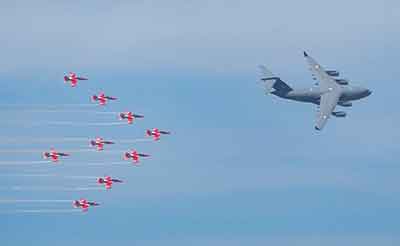Date: 15/02/2023
Relevance: GS-3: Effects of liberalization on the economy, changes in industrial policy and their effects on industrial growth.
Key Phrases: Defence Exports, Import Budget, Aero India, Exports, Entrepreneurs, Development, Manufacturing, HAL, Brahmos, Tejas, Start-Ups, Nuclear-Armed, Invasion Of Ukraine.
Context:
- The Prime Minister recently outlined plans to more than triple annual defence exports to $5 billion over the next two years, as arms companies swarmed to a major air show for a piece of the country's vast import budget.
Key Highlights:
- India hopes to sign defence deals worth $9 billion at Aero India, a five-day event that happens every two years. This will be the biggest deal India has ever made. This comes as its airlines try to finish buying jetliners to meet civilian demand and push global aircraft manufacturers to make more planes locally, mostly through partnerships.
- For decades, India has been one of the world's largest purchasers of defence equipment, yet it has consistently underperformed in the global weapons export market.
- India's export goals reflect the country's expanding clout, as it leverages massive imports to encourage investment in its domestic sector.
India’s Defence Exports:
- India’s previous exports include Hindustan Aeronautics (HAL) Dhruv
helicopters to the Philippines, Mauritius, and Ecuador, as well as
supersonic cruise missiles from the Russia-India joint venture BrahMos
Aerospace to the Philippines.
- HAL has also offered Malaysia the sale of its Tejas light fighter jet.
- Other items exported by India include offshore patrol vessels, coastal surveillance systems, avionics, chaff rocket launchers, and radar spares.
- The air show aims to promote exports of indigenous air platforms such as Tejas, Dhruv, HTT-40 training aircraft, Dornier light utility helicopter and the light combat helicopter.
- India also wants smaller domestic firms and start-ups to manufacture parts for huge defence goods around the world, as well as to attract foreign investment for joint product development and production.
Do you know?
- India achieved exports of defence items and technology worth a record Rs 13,000 crores in 2021-22 and this figure is likely to rise to Rs 17,000 crores in 2022-23.
- Positive indigenization lists of over 3,700 items including components/line replacement units for defence public sector units, and 310 other defence related items have been issued by Ministry of Defence to promote self-reliance.
- According to data from the defence ministry, India's defence exports nearly quadrupled between 2017 and 2021, rising from 1,520 crore to 8,435 crore.
- It is being speculated that by 2023, defence exports will cross ₹19,000 crore and India could achieve the target of ₹25,000 crore worth of exports by 2025.
Pressure to Diversify:
- Aerobatic performances by aircraft such as Tejas and Russian-made
Sukhoi 30 fighter jets were applauded by officials at the Aero India
exhibition.
- However, sharing borders with nuclear-armed rivals China and Pakistan, India's largely Soviet-era air force fleet is in desperate need of modernization.
- Russia supplied India with roughly $13 billion in weaponry over the last five years, and vendors in the European Union and the United States have been fighting for a larger portion of the market.
- Russia's invasion of Ukraine has made it imperative for India to further diversify its supply base, amid fears of possible Russian supply disruption and Western pressure on the nation to limit ties with Moscow.
- India’s airlines are also expanding, with Tata Group’s Air India
expected to announce a potentially record deal to buy nearly 500 jets from
Airbus and Boeing, worth more than $100 billion at list prices.
- Although unlikely to be announced at the air show, the transaction coincides with India's largest industry meeting, where suppliers seek to secure spin-off contracts from the country's defence and civil aviation expansion.
Conclusion:
- The Prime minister mentioned that India is not just a market for defence companies; it is also a potential defence partner. He also called on India’s private sector to invest more and more in the country’s defence sector.
- Government is pushing an ambitious program of turning the nation into a defence manufacturing hub. The country has banned imports of over 300 defence systems and subsystems in order to boost local players.
- The journey from having only a 0.2 percent position in the global arms export market to being a significant exporter will be a long one but is very much achievable.
Source: Live-Mint
Mains Question:
Q. Defence Industrial Corridors will catalyse indigenous production of defence and aerospace-related items. This can reduce our imports and promote the export of items to other countries. Comment (150 words).







